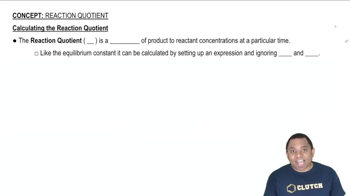Here are the essential concepts you must grasp in order to answer the question correctly.
Gibbs Free Energy (ΔG)
Gibbs Free Energy (ΔG) is a thermodynamic potential that measures the maximum reversible work obtainable from a thermodynamic system at constant temperature and pressure. It indicates the spontaneity of a reaction: a negative ΔG suggests a spontaneous process, while a positive ΔG indicates non-spontaneity. Understanding how ΔG changes with varying conditions, such as concentration or pressure, is crucial for predicting reaction behavior.
Recommended video:
Gibbs Free Energy of Reactions
Le Chatelier's Principle
Le Chatelier's Principle states that if a dynamic equilibrium is disturbed by changing the conditions, the position of equilibrium shifts to counteract the change. In the context of gas reactions, increasing the partial pressure of a reactant (like O2) will shift the equilibrium towards the products if the reaction produces fewer moles of gas, thereby affecting the ΔG of the reaction.
Recommended video:
Reaction Quotient (Q) and Equilibrium Constant (K)
The Reaction Quotient (Q) is a measure of the relative concentrations of products and reactants at any point in a reaction, while the Equilibrium Constant (K) describes the ratio at equilibrium. Changes in partial pressures can alter Q, and when Q is compared to K, it helps determine the direction in which the reaction will shift, thus influencing ΔG. Understanding these concepts is essential for analyzing how changes in conditions affect reaction spontaneity.
Recommended video:





